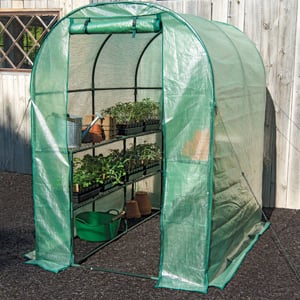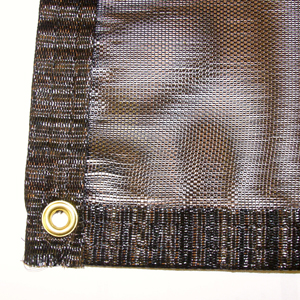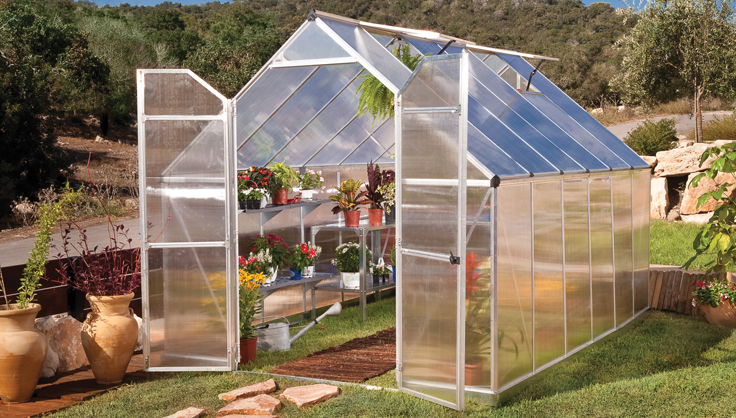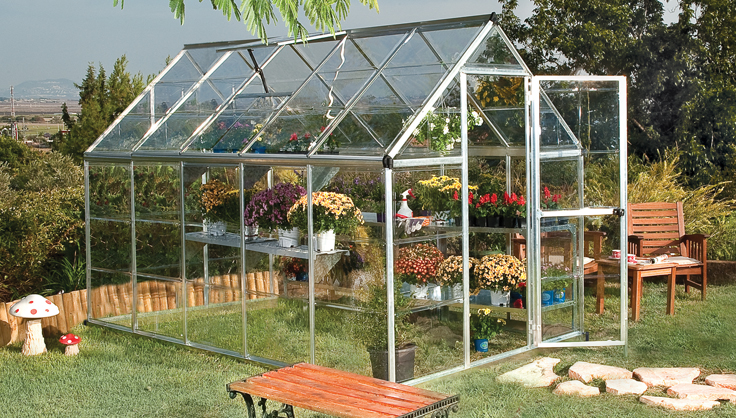Greenhouse Gardening
Take your garden to the next level with a greenhouse
Most gardeners would love to own a greenhouse. Some gardeners might be most intrigued by the idea of a tropical environment filled with orchids, citrus, and jasmine. Others might relish the opportunity to pick fresh salad greens and vine-ripened tomatoes on a cold winter day. There are now many well-constructed greenhouses in a range of prices, as well as numerous accessories that make greenhouse gardening easier than ever!
In This Article
What Do You Want to Grow?
Historically, enjoying fresh-picked hothouse tomatoes and cultivating exotic tropical plants was the realm of the wealthy, who could afford ornate, free-standing greenhouses, hard-to-find plant material, expensive climate-control equipment, and staff to tend to it all. To lend an even greater aura of sophistication, magnificent Victorian-era greenhouses were often called conservatories or orangeries.
If you're in the market for a greenhouse, the first step is simple: What do you want to grow? Year-round, cool-season edibles, like lettuce? An extended season of warm-season crops, like tomatoes? Or how about armfuls of cut flowers?
Today, there are many greenhouse options, from affordable pop-ups to permanent installations and everything in between. An attached greenhouse or sunroom might the right choice if you want a place to read and putter among potted plants. On the other hand, can you imagine yourself tending an extensive collection of orchids, propagating begonias, and experimenting with oleander and passionflower? If so, you'll want a well-insulated, professional-quality greenhouse that can be temperature-controlled year-round.
Getting Started: Light and Temperature Needs
Plants differ widely in their preferred growing environments. Some plants need warm days and cool nights. Some like lots of bright light to thrive and produce fruit, some require filtered shade or their leaves will scorch. Some must be exposed to specific amounts of light and darkness to produce flowers and fruit. Where does a greenhouse fit in?
Most greenhouses, with their thin, clear or translucent coverings, will readily overheat in the midday sun, and then chill down quickly after sunset as temperatures drop. Few plants thrive in these desert-like extremes of heat/sun and cold. In most climates, to use a greenhouse year-round you'll need special cooling and/or heating equipment.

A Greenhouse for Spring and Fall
The simplest option is to use the greenhouse at select times of year when the weather is cooperative, such as spring and fall in most regions. Whether it's a simple pop-up greenhouse or a more elaborate one with vents and fans, it will protect plants in spring from chilly temperature and wind, making them idea for spring tasks, such as
- starting seeds
- hardening off transplants
- transitioning indoor plants
Note that even when air temperature is pleasantly cool, the temperature in a greenhouse can heat up rapidly in midday sun. Vents can help keep the interior cooler, but you'll need to monitor the temperature.
In fall, this type of greenhouse is ready to extend the harvest season and help transition houseplants back indoors. Many pop-up-type greenhouses feature a sturdy frame, and a custom-sewn greenhouse cover made from clear or translucent material that slips over the top. Zippers provide access to plants and offer ventilation. Some aren't winterproof; that is, they may collapse under heavy snow cover, and should be dismantled at the end of the growing season.
A Three-Season Greenhouse
To further manage heat buildup, some greenhouse owners cover their structures with shade cloth to lessen the impact of mid-day sun. Shade cloths vary in the amount of light they let through. (An alternative option is the whitewash the top and sides to lessen light filtration.) Adding fans and an automatic venting system helps keep the temperature down inside the greenhouse. You may be able to keep plants happy though all but the hottest days. However, depending upon your climate, there may be times when your greenhouse just is just too hot for what you want to grow.


A Year-Round Greenhouse
If you plan to run your greenhouse year-round, you'll need a plan for keeping it cool in summer and warm in winter. Your options vary widely on climate; if you're investing a good deal in this project, consulting a local greenhouse grower. If your locale experiences extreme heat and cold, you'll need reliable cooling and heating apparatus. Here are some tips:
- Determine what plants you want to grow and determine the temperature range you'll need to maintain for those plants — both in winter and in summer.
- Wintertime temperatures ranging from 40 to 60 degrees F may be ideal for growing salad greens, herbs, camellias, and for overwintering tender exotics. But these temperatures are too cold for producing healthy tomatoes, gardenias, and tuberous begonias. Depending on your location, winter's shorter day length can further challenge plants.
- During the summer months, bright sun and daytime temperatures of 85°–90°F may be fine for potted tomatoes, bananas, figs, and geraniums, but alpine plants, African violets, and many types of orchids will not tolerate the heat.
One you know the temperature range you'll need to maintain, you can explore your options for heating and cooling, which will depend on your climate; the size, shape, and materials of your greenhouse; and your budget.
Note that within any greenhouse, there are certain areas that are hotter or cooler, brighter or shadier. Just like in your outdoor garden you can take advantage of these natural microclimates to provide optimum growing conditions for a wider range of plants. For example, in summer you might grow cool-loving greens on a low shelf where it's a bit cooler and shaded by benches.
Note that despite the challenges and cost of choosing, installing, and maintaining a year-round greenhouse structure, many people who have one — and have tasted the pleasures of being able to putter around in their own warm, plant-filled jungle — would be quick to argue that the benefits outweigh the challenges.
Important Considerations
Water. Plants need a consistent supply of water, and those growing under a roof sheltered from rain depend entirely on someone to provide it. Locate your greenhouse near a water source. If you plan to grow plants year-round, you must have a year-round (non-freezing) water source.
Power source. If you're running fans or a heater, you'll need a safe supply of electricity. If you need to bring a source to the building, have an electrician install it so it has adequate power for your equipment and is safe to use around water. Avoid simply running an extension cord.
Supplemental lighting. Although this may an seem an odd need when the structure is open to direct sunlight, remember that, depending on your location, days are shorter in the winter with as little as eight hours of light. Clouds will further reduce the amount of light that reaches your plants. and of winter days. Your seedlings, as well as daylength-sensitive plants, may end up hungry for light and would benefit from LED lights installed over plant benches.
Appearance. Will you be happy with a plain polyethylene hoop house in your back yard? Or is it important that your greenhouse be a more aesthetically pleasing addition to your home and your landscape?
Permits. Depending upon your county and city laws, a permanent or temporary greenhouse may require one or more permits. Before you start shopping, check with your local authorities and get the specific regulations that pertain to your situation. HOAs may also have restrictions in their by-laws.
What Types of Greenhouses are Best for Home Gardeners
- Custom Design or Kit? With the availability of so many different styles and price ranges of greenhouses, that there's little reason to start from scratch designing your own. The exception to this is if you are building a new house, or are concerned about integrating your greenhouse into the architecture of your home. In this case, it may be wise to seek some professional advice. Greenhouse kits may be as elaborate as a site-built gazebo room with turrets, or as simple as a box of plans with some hardware and a roll of polyethylene. Send for literature on all the greenhouse kits that interest you. Get on the Internet. Ask other gardeners about their experiences. And be sure to find out whether the supplier provides technical support.
- Freestanding or Attached? Having a greenhouse connected right to your home has many advantages — especially if you want to grow year-round. You can wander in and out to see what’s happening at any time, day or night, no matter what the weather. With your plants so close at hand, it's easier to remember about watering and other tasks. Access to water and electricity is also easy. On sunny winter days, an attached greenhouse can add a significant amount of free heat to your home. But attached greenhouses have a few downsides as well. Without proper venting and a way to isolate the greenhouse from the rest of your house, it may make your home too warm in the summer, and can keep your furnace running day and night in the winter. Freestanding greenhouses are usually less expensive than attached models, and are much easier to set up. They can be placed right on the ground (though if you intend to heat the greenhouse through the winter, in cold regions you should consider insulating the foundation down to the frost line). If you will only be using your greenhouse seasonally, a freestanding model will be relatively out of sight during the “down-times” of midwinter and midsummer.
- Classic or Modern. If you're leaning toward a permanent structure, you'll want to ensure that the shape and style of the greenhouse is compatible with your home and landscape. Even the most elegant Victorian-style greenhouse might feel incongruous next to a New England saltbox. Northern gardeners must also consider snow load when choosing a greenhouse. If snow doesn't slide off the roof naturally, you'll have to shovel it off to protect the glazing and allow light to enter the greenhouse. The overall shape of the greenhouse also determines the interior space and how it can work. Make certain that the style you choose provides enough headroom, wall area for displaying plants, a work area and enough roof area for venting.
- Glass or Plastic. Glass is still the traditional choice for greenhouse glazing (the technical term used for the transparent or translucent covering), but there are now many high-quality horticultural plastics to choose from, including polycarbonate, acrylic, polyethylene, and Tedlar®. When selecting a glazing material, you need to consider appearance, lifespan, whether you need single- or double-glazing, how weathertight your greenhouse needs to be, and price. Traditional multi-pane glass greenhouses are notoriously difficult to seal. Modern attached greenhouses, with large panes of insulated glass, are usually very weathertight. If you live where the ground freezes, a glass greenhouse needs to sit on a permanent foundation, or frost heaves could break the glass. Glass lasts almost indefinitely, and its light transmission is very high. That said, plastic glazings offer some distinct advantages over glass. They are far more forgiving of temperature fluctuations. They are easier to handle (lighter weight and non-breakable). They diffuse incoming sunlight, which prevents leaf-scorching. Last but not least, they won't be shattered by an errant Frisbee or softball.
Our Greenhouse Picks
For popping up in the yard: Sunbubble Greenhouse
For jumpstarting your seedlings on the patio: VegTrug Patio Greeenhouse
For an extra big, like really big, gardening operation: MONT 8'x24' Premium Greenhouse
For elegant backyard growing: Canopia Hexagon Greenhouse
Owning a greenhouse can give you the opportunity to grow plants from all over the world. Once you've made your decision and installed your greenhouse, take time to monitor the condition inside and fine-tune the heating and cooling apparatus, if applicable. Once you are confident of the conditions, it's time to let your plant imagination go wild!
This article is a compilation of articles and information by Kathy LaLiberte and Suzanne DeJohn.
Print this Article:
Get the Dirt
Stay up to date on new articles and advice. Please fill out the information below.

